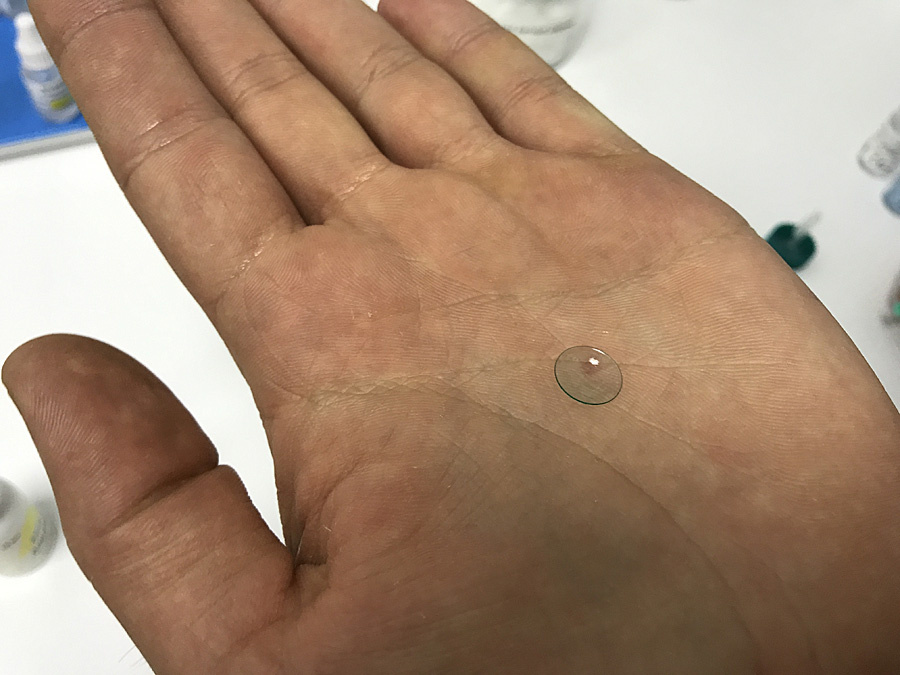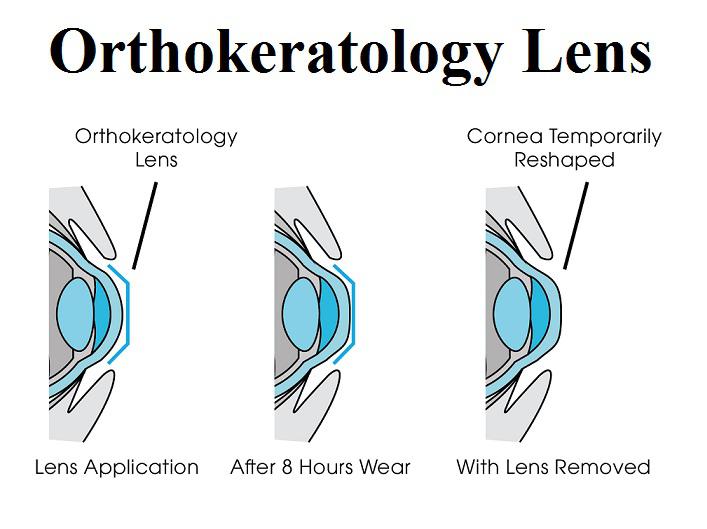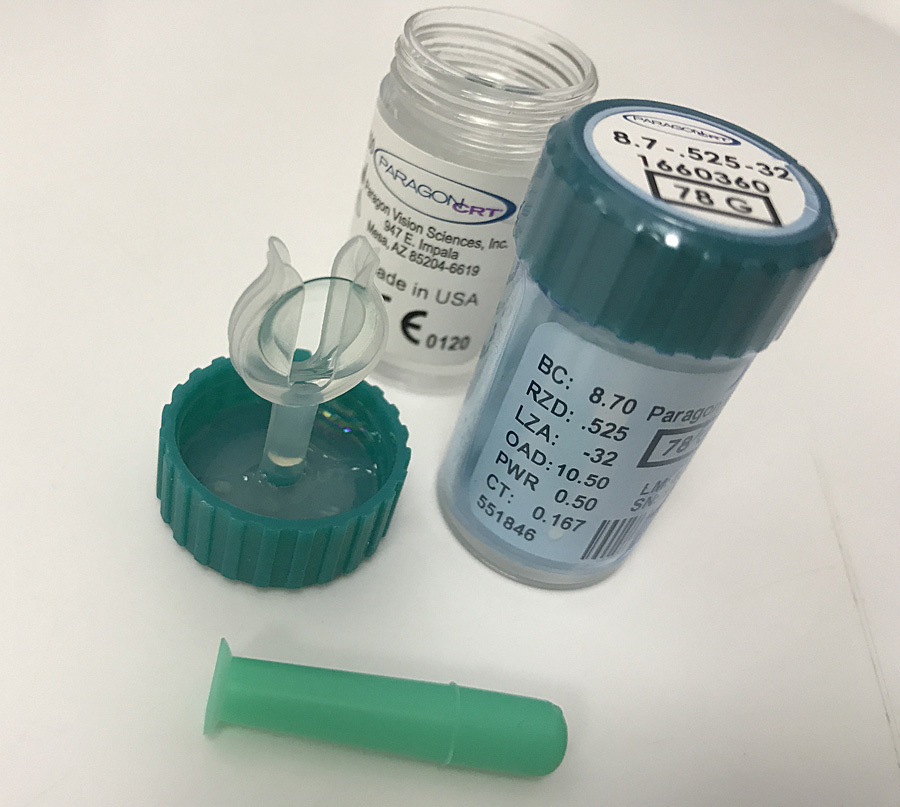
The last method in our vision correction cycle is hard contact lenses for night use. They are second to safety after points. Conventionally, the safest correction method is definitely glasses (with durable polycarbonate lenses), then ReLEx SMILE and hard night lenses, then femtoLASIK and PRK, then soft one-day lenses, then “barbaric methods” — soft lenses of long-wearing and LASIK. Separately, there are phakic intraocular lenses and artificial lenses — they are best done only by direct medical indications (quite an invasive method for refractive indications).
The main advantage of night lenses is clinically proven to stop progressive myopia. Therefore, they are often prescribed to children when the eye is actively developing. After 20 years, this effect decreases by an order of magnitude, but a couple of other advantages remain.
Payback for the obvious advantages — the high price of such lenses, the need for strict discipline and regular sleep for at least 7 hours.

How do hard lenses for night wear
In the evening, you take a container with lenses and special manipulators. Put on two hard lenses right before bedtime. The first few times it will be painful, but if you wear the usual soft, get used to it quickly. If not, it is better to try one-day first for a couple of weeks, because losing a hard lens from the inability to wear or wear (from bathroom to bed) is just a pity. After soft lenses, using hard night lenses is very, very simple just because they hold their shape well.
These lenses begin to press on the cornea, «lowering» its center and the tissue under it in a natural position for normal vision. A correctly calculated lens does not “rape” the eye, but returns the focal length of the eye to the natural physiological one. To make it clearer, let me remind you that myopia is actually a tensile deformation of the eye.
The cornea has a sufficiently rigid collagen matrix, so it begins to “memorize” a new shape set by a lens. Conditionally, for 3-5 nights of wearing, normal stable vision is achieved within 95%, and then the result is fully communicated in a couple of weeks. The first days will need to be worn or weak points (for example, for –5 on the first day it will be –3.5, then –2, then –0.5), or suffer.
Then you will need to comply with the regime. To preserve the shape of the rigid lenses will need to wear every night and sleep at least 7 hours (and try no more than 10-11, in time to remove them). Less — a little worse vision in the afternoon. More — not very scary, most importantly, do not abuse so tens of days in a row.
If you miss the night, your eyesight will drop a little — the cornea will begin to take shape, characteristic of your short-sightedness. On the first day, you will receive an under-correction of –1 or –1.5, then — incrementally, stabilization at the same time. If you miss the night and start wearing the next night — the next morning everything will be all right again.
The only point: for those who have sight to –2.0, you can wear the lens through the night if desired.

What is the maximum correction?
From –0.5 to –6 diopters in a sphere depending on the shape of the cornea and up to –1.75 in astigmatism. For some people with a flat cornea, this correction method has a narrower corridor of restrictions. There are Russian lenses with a large correction corridor, but less oxygen-permeable material.
Are there lenses for correcting hyperopia?
Yes, there have been experiments with lenses that are reversed and put pressure on the edges of the cornea. But they are more expensive and less often, they were actually done manually in one clinic. As a result, this method was abandoned.
How to choose hard night lenses
These lenses can not just go and buy at the pharmacy (in theory, of course, you can, but you should not do this) — you first need to get the exact parameters for your eye. The procedure is as follows: after a standard diagnosis in the clinic, they choose lenses from a suitcase with about 160 variants of lenses. Somewhere from half an hour to an hour you try them on until you feel that this one is sitting perfectly (that's why I recommend first learning how to wear one-day, otherwise the diagnosis will be rather unpleasant — for example, we often have children crying to their eyes touch). As soon as you find your ideal lens with your eye, the optometrist will apply a fluorescent solution on it, which will glow in the IR illumination of the microscope. In a circle on the corneal epithelium, it will be possible to understand how correct your “ideal” was in fact. After a double check, you will receive either ready-made lenses (if the clinic specializes in calculating them), or they will be ordered for you in the USA and arrive in a couple of weeks. In our practice, given the not very large number of options for busting (most often need 10-20 of the most characteristic models), go home immediately with new lenses.
Sometimes patients are sent to us from the manufacturers of lenses for diagnosis, in order to get the results of the Shympflug camera (Pentakama), because you need a combination of the convenience of finding the lenses on the eye and their selection accuracy. You need both sets of equipment — expensive diagnostics and a suitcase with a bunch of accessories.
These lenses are expensive, cost about 28 thousand rubles per pair, plus you need to do 4 inspections rationally during the first month, then once every 3 months. In general, with regular contact lenses you need to look around regularly, but few do.
Every year, you need to throw out the old ones and buy new ones, without overstating it. They also need the usual storage solution (first portion), containers and manipulators — in general, everything you need. This is also usually included in the price, as well as diagnostics.

If night lenses are chosen for children with progressive myopia (in order to stabilize the process at the expense of peripheral defocus), there is another feature. Up to 18 years old, according to the law, the parent is fully responsible for his child, so the procedure for selecting and learning to use is done strictly with the mother or father, and at the age of 15 and at the age of 6. Yes, you can use them starting from about 6 years old, it does not make sense before — the child is likely to lose them.
Oxygen access: why are they so cool and safe
There are a lot of good Russian models cheaper, but we use American ones — they are about two times thinner. This immediately excludes all other lenses from the choices. Yes, there are cheaper options, but we put on hard contact lenses when the patient needs comfortable vision without glasses, and without surgery, or when it is necessary to stop the progressive myopia in a child. I want cheaper — stay on the glasses, it is more reasonable for safety.
So, despite the rigidity of the material, fluoride-silicone-acrylate has a structure that does not prevent the flow of oxygen to the eye (almost mythical 100% oxygen permeability), that is, night lenses are much safer than soft lenses in this regard. Given the almost guaranteed limited time to wear (I know very few people who can sleep for 12 hours regularly), the safety requirements will be met almost automatically. This is a direct consequence: we have no patients with complications due to such lenses. But, really, I must say that we are somewhat cunning when we talk about long-term wearing: usually by the end of the year the patient becomes so accustomed to the fact that you can freely run, jump and swim, who really wants to get this vision, but wear lenses, and follow the schedule too.
Therefore, the patient usually comes to laser correction, enjoying life and considering the costs for the coming years. As a result of long-term perennial cases of wearing hard night contact lenses in Russia, there are only a few hundreds — as a rule, those who use them because of the impossibility of another correction and unwillingness to wear glasses. Usually — female models and athletes, mostly boxers and hockey players.
Who uses hard night lenses?
- Those who can not correction, but wants to walk without glasses.
- Those who are engaged in active sports (it is difficult to imagine a surfer with a dropped out lens or a tennis player with glasses). And so at night vilified — took out for the day.
- Those who are waiting for vision correction and want to understand how it will be after (note: hard lenses need to stop using a month before the preoperative diagnosis).
- Those who live and work in regions where there are frequent drops from heat to cold (glasses mop up and make it difficult to work comfortably, for example).
- Children and adolescents with progressive myopia, when you need a physical limitation of the mechanics of the cornea.
- Those who are not sure that vision stabilizes after laser correction.
Do not confuse
Another moment. All that is written in the post regarding the safety of hard contact lenses applies only and exclusively to special lenses for night use during sleep. There are also hard contact lenses, which are used for ordinary corrections, and those that are used after surgery to create an additional exogenous eye frame. Almost none of the above applies to them, they are often worn out of forced necessity.
And one more important point: yes, there are rigid lenses that are machined individually under a curve like a sinus cornea (most often after transplantation or serious operations) and give perfect vision. In such corneoscreen lenses, the mechanism for creating a fluid medium (tears) between the corneal tissues and the lens is that they do not sit on the cornea, but on the conjunctiva. They are made only by one clinic in Russia, as a solution to the “last chance”, the testimony is extremely specific. If interested — I will give a tip in PM.